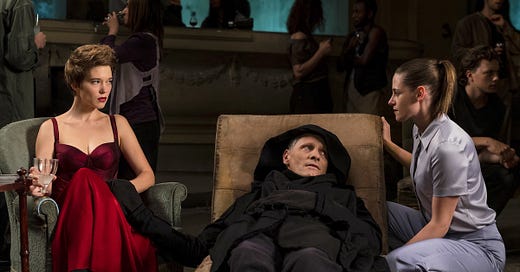‘Crimes of the Future’ Review
David Cronenberg’s meditation on art and transformation in an industrial age.
Crimes of the Future is undoubtedly a bit weird. And it’s not for the squeamish, opening as it does on the murder of an 8-year-old boy and closing as it does on that boy’s autopsy. But the provocative weirdness serves a purpose, as one would expect from David Cronenberg.
The film posits a future in which human bodies have developed an immunity to pain—no one can feel anything anymore—except for a certain few who are roiled by agony in their sleep as a result of the fact that they are spontaneously generating new organs. The lack of pain aids in the organs’ removal, and allows for performance artist Saul Tenser (Viggo Mortensen) to have said organs extracted by Caprice (Léa Seydoux).
What has the future criminalized? Well: change. As an artist, Tenser’s whole project is trying to arrest the changes taking place within himself; he removes the organs in order to keep them from killing him, turning them over to Timlin (Kristen Stewart) and Wippet (Don McKellar). Detective Cope (Welket Bungué), an investigator with the New Vice Unit, holds secret meetings with Tenser in an effort to discover the goals of those who embrace the new flesh. One such individual is Lang Dotrice (Scott Speedman), the father of the boy killed in the movie’s opening moments and the producer of a new, plastic-based food designed to work with the digestive tracts of an evolving populace.
As a leading practitioner of the subgenre known as body horror, Cronenberg is well suited to examine the nature of changing embodiment and what it means. There’s something deeply off-putting about not only the surgeries we see performed—the removal of vestigial organs; scarring on a beautiful woman’s face designed to make it appear as though she has gills; a dancer who has sewn ears all over his body—but also the extent to which people go to remain “human.”
Saul goes to bed each night in a bed that looks a bit like a giant alien vagina, tubes stuck in his arms in order to diminish the pain he suffers while sleeping. He can’t eat normally any longer thanks to the mutations; to consume his nutrients he must sit in a flesh-colored chair with appendages that jerk him back and forth, forcing the food down his throat and into his stomach.
Maintaining one’s humanity, then, is a bit of an ordeal. Fighting against the natural evolution, struggling against what the environment is trying to do to their bodies: it’s tormenting. Would it not be better to accept change, to allow evolution to take its course? There’s certainly a read of this film that suggests as much. Cops are, naturally, untrustworthy and bad; murdering children for trying to live their bodily truth—even if that truth reveals itself in bizarre ways, like eating plastic for nourishment—is horrifying. Change is good. Accept change. Get with the times, man.

And yet. And yet.
Getting with the times and accepting this bodily autonomy means Tenser would have to abandon his art, abandon the thing that gives him meaning. Getting with the times means accepting a synthetic future, one in which the body’s response to industrialism is to literally eat plastic. Getting with the times means joining the masses in celebrating Ear Man, someone whose work, as Tenser puts it, can only be appreciated “if you like escapist entertainment.”
In other words: getting with the times will make Tenser’s life materially easier but it will rob him of something that gives that life meaning. And while it’s often a mistake to project a filmmaker into his work, I’ll be honest: It’s hard not to think of Cronenberg while watching this movie about a revered indie artist who feels the need to stifle his jealousy as he watches hacks who make escapist entertainment earn huge audiences. That Crimes of the Future is sandwiched between Top Gun: Maverick and Jurassic World Dominion on the release calendar only heightens the sensation.
Maybe, then, the worst crime you can commit in the future is failing to push back against what the future hath wrought.





